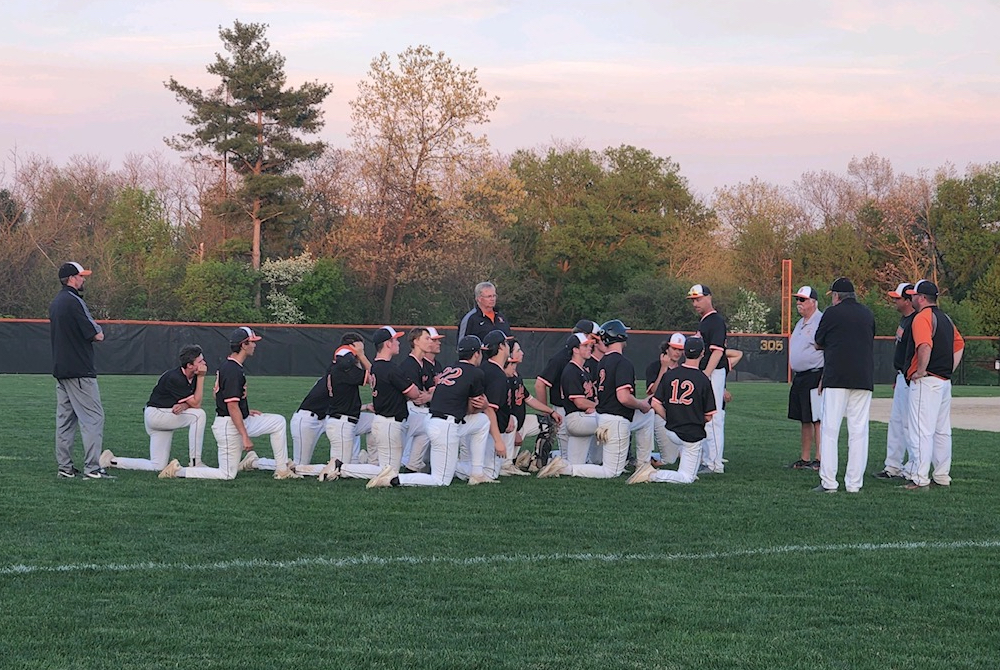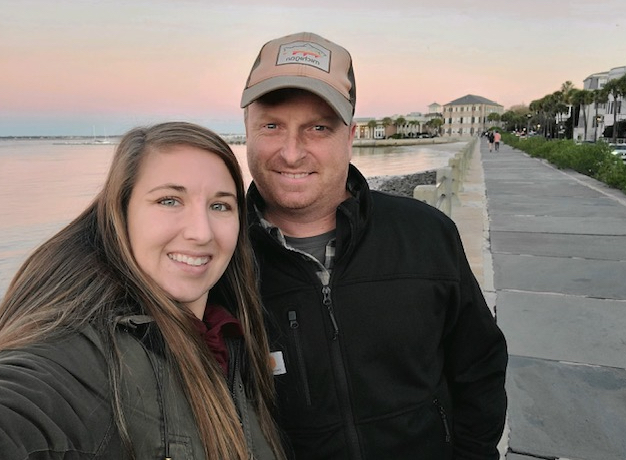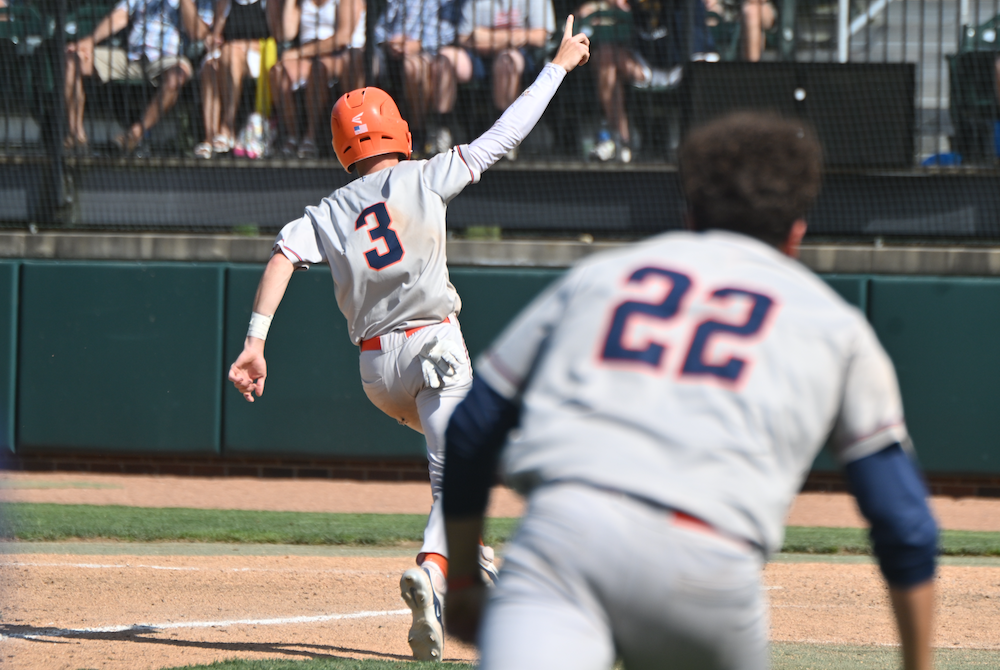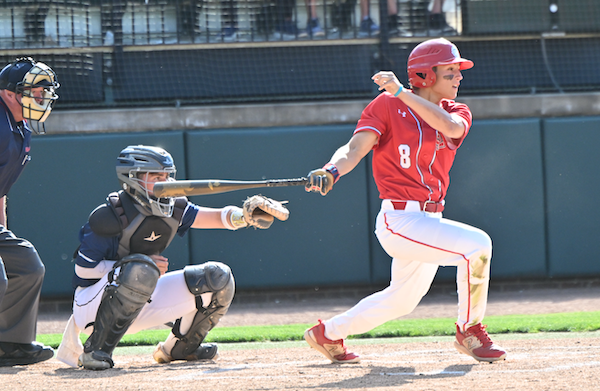
Brighton Baseball, Community Rally as Coach Comes Back Strong from Health Scare
By
Tim Robinson
Special for MHSAA.com
July 13, 2022
At first, Charlie Christner thought it was a case of heartburn.
 It was Jan. 12. He had taught social studies at Scranton Middle School for five hours and now was beginning his prep hour by preparing for his other job as baseball coach at Brighton High School.
It was Jan. 12. He had taught social studies at Scranton Middle School for five hours and now was beginning his prep hour by preparing for his other job as baseball coach at Brighton High School.
“I was actually … in my last hour (of) the day, and just started having heartburn,” he said.
So he made a quick trip to a nearby store to get an over-the-counter heartburn remedy.
“I wanted something to help me before I went to (offseason) hitting,” he recalled.
But the feeling didn’t go away, and about 4 p.m. Christner told his coaches he wasn’t feeling well and was going home.
He didn’t get there.
“I made it about a mile down the road and had to pull over and just started throwing up,” he said. “(I) felt better and started back down the road and stopped, (and) just started throwing up again, and I said ‘I’ve got to get to the hospital.’”
He called his wife, Jackie, who was at home working, and she rushed to the hospital.
Once he was admitted, Christner was diagnosed with pancreatitis.
Waiting out a serious situation
The pancreas is a gland located under the stomach which secretes hormones, including insulin, to aid in digestion.
In Charlie’s case, gallstones had blocked the ducts connecting his pancreas to his small intestine. This, in turn, was leading to part of the tissue in his pancreas beginning to die.
Over the next several weeks, the Christners made several trips to the hospital while he dealt with pain and a gradual buildup of fluid due to a cyst that had formed around the inflammation in his pancreas. The cyst made him feel full all of the time and made it difficult to eat or drink.
The pain medication affected him, too.
“It messed up his thought process a little,” Jackie said. “Some days he didn't know what day it was or, you know, he doesn't remember those days.”
Although the diagnosis was fairly swift — the Christners knew from the beginning what was wrong and what needed to be done — surgery was delayed for nearly two months to let the inflammation in his pancreas go down.
But it was still a serious situation.
“It’s a most sobering experience to have a surgeon come out and tell you your son is very sick and it’s a very serious situation and has a 70 percent chance of survival,” said Dan Christner, who coaches with his son after a long career as a basketball coach at Brighton. “I’ve seen enough missed free throws to know that if you make 70 percent of your free throws, that means 30 percent aren’t going in. It gives you pause, and (you) say let’s make sure we’re a part of that 70 percent.”
 The delay was to help increase those odds.
The delay was to help increase those odds.
“They didn't want to do surgery (right away) because of all the inflammation and everything that's going on inside your body,“ Charlie said. “If you have to do it soon, then you end up being in a position where the odds of surviving are less if we have to do emergency surgery. So they delayed it.”
Charlie and Jackie made several trips to and from the hospital during the six weeks after the initial diagnosis.
When he felt up to it, Charlie was working on lesson plans along with administrative tasks while his coaches ran offseason workouts.
“He really wanted to make sure things were coordinated,” Jackie said. “And you know, that's Charlie to a T. He wants to make sure that everything runs smoothly and in that, you know, he's informed of any decisions or changes or things that are happening with the team.”
A veteran coaching staff, led by former Pinckney baseball coach Matt Evans, stepped into the breach.
“I think the big thing on our part was making sure that it was business as usual,” Evans said. “We weren’t going to let Charlie not being there through the winter be an excuse for why we performed or didn’t perform. He’s been a stable force and head of the program for a number of years now. We knew what we needed to do, and so it was about executing a plan that's pretty familiar to us.”
Christner went to a few offseason workouts, watching from a chair.
“(Jackie) would drive me up to hitting and I'd sit in there and watch the guys for as long as I could, 30 minutes or an hour, just to give me something to do," Charlie said. “Otherwise it was, you know, a lot of daytime TV and naps. I did do some stuff with baseball during that time, even if it was just to go watch hitting for an hour and talk to the coaches on how kids are doing. ... It gave me definitely something to do and something to look forward to.”
In the meantime, the Christners were flooded with cards, texts and phone calls of support, prompting Jackie to post regular updates on her Facebook page to lighten that load.
Their families were supportive, as was the community.
“Everybody was so gracious and heartwarming and opened their arms to us and said, ‘anything you need,’” Jackie said. “There's nothing that we really needed that the community could help us with too much because we were just stuck in a hospital, just kind of sitting there waiting for medicines, waiting for diagnosis, waiting for the doctor to progress the treatment, etc. And that was kind of what we needed.”
“I’m proud of the way that everybody came together and did what had to be done, and how excited people were to see him," Evans said. “That speaks to the time that Charlie’s put into this program over the last however many years as a coach, Any time you’re a coach, you look for those moments you can point to as having a positive impact on kids and the baseball community and all those things, and I would say the willingness of everyone to pitch in is a testament to how much he’s appreciated as part of the Brighton baseball community.”
On the way back
Surgery was March 3. Christner’s gallbladder was removed, along with the dead tissue on his pancreas. A pair of cysts were drained, and he went home a few days later.
Christner, always slender in physique, had lost 40 pounds – 10 of which liquid that had been building up in the cysts.
But, albeit from a chair, he was at tryouts March 15.
His voice was weak at first, but he made his presence known.
“When he was back at tryouts, those first couple times, he would cut loose and let out a yell,” Evans said. “And it was ‘OK, Charlie’s back, and he’s in it,’ and that made everyone feel good. Same old Charlie. He’s locked in. Same old competitor.”
A frustrated competitor, at one point, irritated because fungos weren’t being hit by his coaches in the manner he prefers. But he coached from third base, albeit from his normal spot a step or two from the dugout.
He progressed from liquids to solid food (his first solid food was pizza), and returned to the classroom April 12, three months to the day his medical odyssey began.
After an 8-8 start, the Bulldogs won District and Regional titles before falling in a Division 1 Quarterfinal.
The healing continues, but things are back on schedule for Christner, who turned 40 on Saturday.
He’s not outwardly emotional. He appreciates the love and support he and his family have received, but also wishes he could have accomplished more for his team during the time he was critically ill.
Jackie Christner is not as reserved.
“I just thank God every day that he is healthy,” said Jackie, who married Charlie in 2019. “And yes, our bond has strengthened. I think everything for us just knowing that we need each other and we need people in our lives as everybody does. But especially to know that we had each other and he had me. He often said, ‘I don't know what I would do if you weren't here. I don't know what I would do. If I hadn't met you, this would be 10 times harder to go through if you weren't here.’"
PHOTOS (Top) Brighton varsity baseball coach Charlie Christner, fifth from right, addresses his team. (Middle) Charlie and wife Jackie Christner enjoy a moment on the lakeshore. (Photos courtesy of Jackie Christner.)

Flint Powers Catholic, Spring Lake End Long Waits to Reach Season Finale
By
Scott DeCamp
Special for MHSAA.com
June 14, 2024
EAST LANSING – After his eighth-inning, game-winning hit to finish Flint Powers Catholic’s Division 2 Semifinal win Friday, Chargers senior Gavin Darling gave away the secret to how 42-year head coach Tom Dutkowski stays so young and energetic.
“That dude works out more than probably half the team, honestly,” Darling said. “He’s a great guy, and we just want to do it for him as well.”
What top-ranked Flint Powers is aiming to do is capture a state baseball championship. Powers has that chance after Darling’s walk-off single to deep left field scored Eli Sturgess for a 4-3 victory over Trenton at Michigan State University’s McLane Stadium.
Powers (36-6) will face Spring Lake (32-9) in Saturday’s 5 p.m. Final. The Chargers are seeking their first Finals title since 1980, and first under Dutkowski’s tutelage.
“We want to win for him, man. It’s not only for us, but it’s for him,” Darling said. “He’s been working hard just like we have.”
Powers and pitcher Grant Garman cruised through the first four innings Friday, Garman carrying a perfect game as the Chargers built a 3-0 lead.
Trenton (30-11-1) began to make Powers work for it in the fifth. The Trojans collected five hits and scored three runs in the inning, keyed by Carson Boike’s two-run single, to knot the score at 3.
The tie remained until the bottom of the eighth inning, when Darling came to the plate with one out and the bases loaded. Powers’ cleanup hitter saw a pitch he could drive, and the rest is history.
“Just (looking for) a pitch to hit, man. They were playing in, so I just had to go for it. I don’t care if it’s a bloop single or a shot like that, I’ve just got to do what I’ve got to do,” Darling said. “(It felt) pretty good to know that I had a guy on third that either way, if it’s caught, he’s tagging and we win the game.
“It’s an unreal feeling, man. These guys are my family, and I can’t thank them enough. They have my back just like I have theirs, and I can’t thank them enough.”
Garman allowed three earned runs on six hits with 10 strikeouts and one walk in five innings. Isaac Sturgess picked up the win in relief, not allowing a hit or run with four strikeouts and one walk over three innings.
Garman led the Powers offense with three hits, while Darling had a pair of RBIs.
Caleb Kidd finished with two hits to pace Trenton. Kidd got the start and worked four innings, allowing three earned runs on five hits with five strikeouts and three walks in four innings. Joel Mator took the loss in relief for the Trojans, surrendering one earned run on three hits with five strikeouts and five walks in 3 1/3 innings.
“I can’t say enough about the fight that was in them,” Trenton coach Todd Szalka said. “He had a shutout (perfect game), we’re going into the top of the fifth, he’s throwing a no-hitter, and then, all of a sudden, we challenge them in the dugout and we come away with five hits in the fifth inning. I mean, that’s almost unheard of, especially against a good pitcher like (Grant) Garman.
“No. 1 team in the state, you’re down 3-0, stakes are on the line, you’re looking at your last nine outs and our kids just continued to fight and went into extra innings. They got the big play when they needed it, and we had gotten the big play the last three games with walk-offs. I’m really proud of the way we came out today.”
Dutkowski instructed Darling to be “short to the ball” on his game-winning hit. The coach was very happy for the player, who “works as hard as anybody.”
Dutkowski believes his team is plenty battle-tested, too, competing in the Saginaw Valley League.
“The Saginaw Valley League is a gauntlet, especially for a school like Powers (as) the smallest school,” he said. “Not that we feel bad about that because we’ve got great players this year, but it is tough.
“ … We beat Bay City Western two out of three this year, and we beat Northville in the Flint Champions Tournament. Neither team was pitching their best, but we beat them. Yeah, we’re battle-tested.”
Dutkowski said that in his younger years, he might have been jumping up and down in the third-base coach’s box during the walk-off play.
On Friday, he said he stayed planted and wanted to make sure Eli Sturgess was tagging at third in case Darling’s deep fly ball was caught.
“I used to be what you’d call an athlete. I used to do all the histrionics, but now my job is to kind of keep guys steady, you know – get them back to neutral as soon as possible,” Dutkowski said.
“I have an ankle-foot orthotic. I am drop foot. I had fusion surgery about 19 months ago on L-4/L-5. No, I’m a wreck. I have this carbon fiber thing,” he said as he pointed to his lower right leg, “that keeps me upright. I’m retired now, so I work out.”
Spring Lake 5, Richland Gull Lake 2
“Next pitch” has been a theme for the Spring Lake baseball team during its run to the Finals.
Of course, when you have Zane Stahl throwing the pitches, that always helps.
The 6-foot-6 Louisville commit scattered five hits and pitched to contact in powering Spring Lake to a 5-2 victory.
On Saturday, Spring Lake will be making its first Finals appearance since 1995 and third overall. The Lakers got there Friday in large part because of Stahl, the defense behind him, and timely hitting.
 Stahl, a right-handed junior, struck out four, walked four, and allowed two earned runs in the complete-game effort.
Stahl, a right-handed junior, struck out four, walked four, and allowed two earned runs in the complete-game effort.
“(The defense) has been incredible. I’ve been able to make my pitch,” Stahl said. “You know, it’s not always about strikeouts; it’s about making the pitch and getting a ground ball. I mean, they’ve been able to make the routine plays that they’re supposed to and even make them outside of that, so it’s been great.”
Stahl helped his own cause, too. He finished 2-for-3 at the plate with two RBIs. Oliver Smies doubled twice for Spring Lake, while Gabe Trask had two hits for the Lakers, who have won 19 of their last 20 games.
Spring Lake took a 1-0 lead in the first inning and created separation with four runs in the fifth inning on four hits.
“Somebody else always seemed to pick us up at the right time. We got a couple of nice ground-ball double plays, so some things have fallen into place for us but I’m also a believer, sometimes you make your own luck,” Spring Lake coach Bill Core said. “What we’ve been impressed with so much is somebody always seems to pick up their teammate or somebody’s been coming through with a big play at the right time.
“We’re not a bunch of superstars, but everybody has a role and we’ve got a different hero (each game).”
Gull Lake (26-12) showed life in the later innings, scoring a run on two hits in the sixth and another run on two more hits in the seventh.
Western Michigan University commit Julian Harris took the pitching loss for the Blue Devils. The right-hander allowed three runs (two earned) on five hits with eight strikeouts and one walk in four innings.
“When you get to the final four, no one’s weak, especially against a good arm like (Stahl’s) – you’re scratching and clawing for every run that you get,” Gull Lake coach Reggie Walters said. “If you tie that ballgame up, it just changes the feel of things instead of chasing.
“We wanted to wear (Stahl) down and he started to show that in the sixth and the seventh, but he threw a great game. … It was like, ‘Man, if we would have started it one inning earlier, you don’t know where you’re going to end up.’”
PHOTOS (Top) Flint Powers Catholic's Eli Sturgess (3) crosses the plate for the winning run during his team's Semifinal victory Friday at McLane Stadium. (Middle) Spring Lake’s Gabe Trask drives a pitch.

